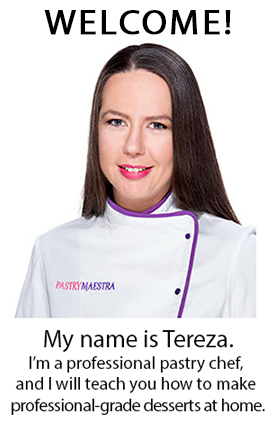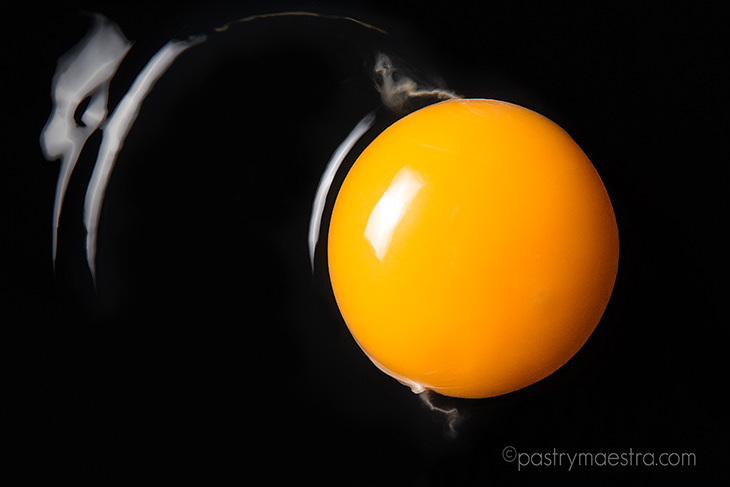
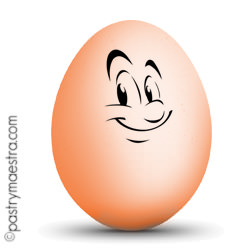
O
ne egg a day keeps the doctor away! Yeah, yeah, I know, it’s the apple, not an egg, but try explaining that that to my grandmother! Every morning, she would cook one soft boiled egg for me and then she would serve it mixed with the crust of freshly baked white bread in a small, yellow bowl with white dots. Aaah, grandma! From time to time she would add a few chunks of cheese in there, just for good measure, to keep the calories count as high as possible, you know, hehe! And I would ate everything, don’t worry. I always loved to eat, and I was an obedient child – when it suited my needs, of course! Well, in patisserie, we don’t make soft boiled eggs, at least not on purpose, but we use eggs for various techniques, and they are one of those, almost indispensable ingredients.
Composition of Eggs
Eggs are laid by females of many species including birds, reptiles, amphibians and fish, and they have been eaten by people for thousands of years. The most often consumed egg, and also most used in pastry is the chicken egg. It consists of three main parts:
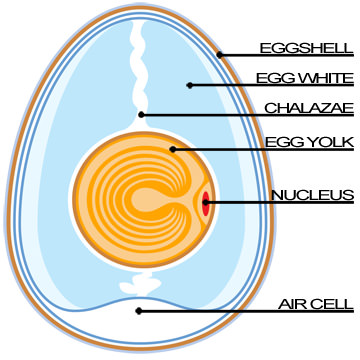
- The shell is composed of calcium carbonate; it is hard covering of the egg that protects its delicate content during handling and transport. The color of the shell can vary from white to brown, and it doesn’t signify the quality of the egg.
- The yolk is yellow inner part of the egg. It contains ¾ of the calories of the egg, in which are most of the minerals and vitamins and all the fat. It also contains lecithin – substance responsible for emulsification. Egg yolk coagulates at temperatures between 65°C – 70ºC (149°F-158°F).
- The albumen or the egg white is transparent, watery part of the egg. It contains more than half of the protein and riboflavin of the egg. Egg white coagulates at 62°C-65ºC (143°F-149°F).
Chalazae chords are thick, twisted strands of egg white that anchor the yolk in place.An average egg without the shell weighs about 50g (1.8 Oz.), where the yolk weighs 20g (0.7 Oz.) and egg white remaining 30g (1 Oz.). Classification and grading of eggs differ depending on the law in each country.
Nutrition Value of Eggs
Eggs are highly nutritious food. They contain essential amino-acids, which are a source of “complete protein” for humans. Besides indispensable protein, eggs also contain vitamin A, vitamin B2, B6, B9 and B12, iron, calcium, phosphorus, and potassium. All of the egg’s vitamin A, vitamin D, and vitamin E are in the yolk. It also contains all the choline, a nutrient essential for the development of the brain.
Eggs and Cholesterol
Most of the calories contained in the egg come from the yolk. In 50 g of eggs, the yolk is 20 g, and out of that 20, 5 g is fat. However, only 27% of egg’s fat is saturated. There is a belief that people on the low-cholesterol diet have to avoid eating eggs, but there are also some researches that claim that the cholesterol from the eggs doesn’t affect the cholesterol in our blood.
Where to Keep Eggs
Eggs should be stored at the temperature below 7ºC (44°F) with humidity 70%-80%. Being rich in protein – which is excellent breeding ground for bacteria, particularly Salmonella – eggs are potentially hazardous food.
Pasteurization of eggs is a process in which the egg is heated to a particular temperature (60°C/140°F) and kept like that for 3.5 minutes. Then it is immediately chilled in an ice bath and refrigerated at the temperature below 4ºC (40°F).
Tip: Never leave egg dish at room temperature for more than 1 hour including preparation and service!
Egg Products
Whole Eggs
Whole eggs (eggs with shell) are available in any supermarket, and they are graded depending on their size. So, there are S (small), M (medium), L (large), and XL (extra large) eggs.

Pasteurized Whole Eggs Without the Shell
This is a product made by pasteurizing whole eggs without shells. The eggs are then packaged in bottles or carton packaging and sold to people who want to avoid the risk of Salmonellosis – a food borne illness caused by the Salmonella bacteria. Or if you just don’t like breaking eggs, this is a perfect product for you.
Pasteurized Egg Whites or Yolks
If you are making meringue cookies, and you don’t want to waste egg yolks, you could use pasteurized egg whites. If you only want to make pastry cream, and you hate the idea of wasting egg whites, you could use pasteurized egg yolks. Once you open the container, you should use it within a few days.
Dried Eggs
Dried eggs are fully dehydrated eggs. The biggest advantage of using dried eggs is, besides its price, a longer shelf life and lack of need for refrigeration. This product was used during World War II in Europe for rationing. In a dry form, powdered eggs can be used in baking, and when rehydrated, they can be used for making scrambled eggs and omelettes.
Dried Egg Whites
Dried egg whites are made by dehydration of fresh egg whites. This product can be used in baking, cooking and making protein shakes, as it contains a high amount of protein.
The Most Important Things You Should Remember about Eggs
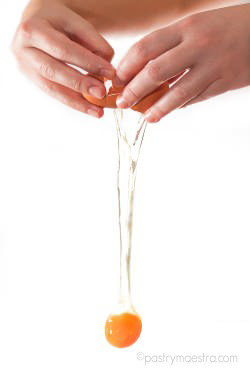
- Egg whites are usually used in form of meringue. That way air is incorporated into a dessert, which can help with rising or making a dessert light.
- Egg yolks are in most cases used as an emulsifier. They help in creaming and combining fatty and watery ingredients into a uniform texture mixture.
- Whole eggs are used for foaming, thickening, or for brushing dough before baking, which gives nice color and shine to breads and enriched doughs.
Eggs are very popular food in the world in spite of the belief in their harmfulness to our cardio-vascular health. Did you know that in 2012 China produced 28.61 million tons of chicken eggs!? The same year, USA produced only (!) 5.2 million tons.
So, there you have it. Now you know everything about eggs and more! Good or bad, those little packages of energy are among essential ingredients in baking so we need to know how to use them. If you also love the taste, the better! As for me – I love to eat eggs, especially sunny side up, with some smoked and cured pork loin. And when I break the yolk with the crust of my freshly baked baguette and watch how it spreads over the whites, aaah…pure poetry! Yummy!


